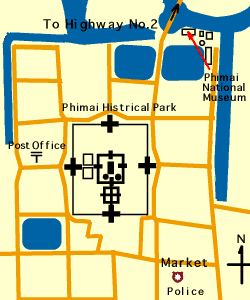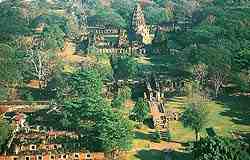[Korat Sight-seeing Map]
[Nakhon Ratchasima]
The Monument of Thao Suranaree
Wat Sala Loi
Wat Prang Taung
Miss Boonlua Memorial
Prasat Phanom Wan
Suan Kaew
Zoological
Ban Prasat Archaeological Site
Phimai National Museum
Phimai Historical Park
Sai-ngam Banyan trees
Prasat Nang Ram
Dan Kwian Land of Ceramic
Prasat Pa Ko
Prang Ku
Prang Sida
Pak Tongchai Silk
Wat Poh Muang Pak
Wat Na Pratat
Prasat Muang Kack
Wat Dharmmachak Semaram
Lam Ta Khlong Dam
Khao Cang Ngam Cave
Wat Thep-Pitak Poonnaram
Klang Dong fruits market
Khao Yai National Park
Prasat Non Ku
[Buri Rum]
Phanom Rung Historical Park
Prasat Muang Tam
[Si Saket]
Khao Phra Viharn
|

|
[ Location ]
About 60 km from Korat city.
From the Highway No. 2, turn right to Road No.206.
Passing a bridge, the Museum is on the left.
And the Sanctuary on the right.
[ Outline ]
Open everyday
Admission time: 9.00 am.- 18.00 pm
Admission Fee: 40 Baht
Thailand's great Northeastern plateau is found to have numerous temples of varying sizes.
Most of these structures are believed to be about a thousand years old and built by the people of Brahmanic culture.
These buildings built of brick, and sandstone, or a combination of the both materials.
The basic structure is built from three to five-story surmounted by Buddhist statues, have a low base and their spires are not so tall.
Phimai is the most spectacular and the most important among all.
|
Geographically, this sanctuary is located on a plain a high plain surrounded by three large canals.
No one knows who actually built Phimai, or why it was built at the particular site it occupies.
However, one source declares,
"It was built in the 12th century and some years before Angkor Wat."
Monsieur H. Parmentier, the Angkorean expert, after a detail study at Phimai came to the conclusion that the temple was built in the reign of King Suriyavoraman (A.D. 1002-1049).
He held that its architectural style closely resembled Angkorean buildings.
|

Click this photo, can see a complete view.
(panorama, 124 k bytes)
|
Prasat Him Phimai which is the largest sandstone sanctuary in Thailand.
It almost situated in the center of ancient Phimai city.
Its rectangular shape is 655 meters wide and 1,033 meters long.
Nowadays, the Sanctuary looks magnificently restored and renovated.
This fascinating ancient Khmer architecture has been preserved as the National Historical Park.
The monument itself is surrounded with two red sandstone walls.
The external wall and the gallery are punctuated by gate towers (Gopura) at four cardinal points, North, South, East and West.
|
|





